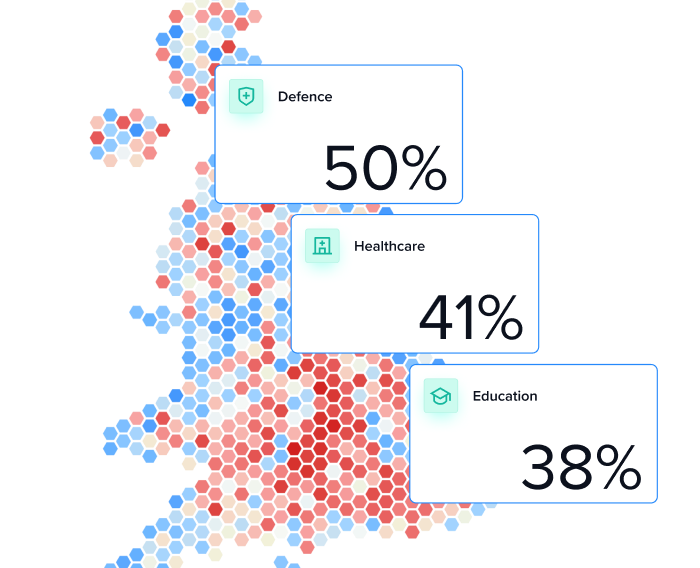Blog/Analysis
How Britain Voted 2024
We have completed our post-election analysis of how Britain voted at the 2024 general election. Using fieldwork conducted over the course of the general election campaign with a sample size of 52,907 unique respondents, we have weighted our responses to the demographics and results in each region of Great Britain.
Full report: Download for an expert breakdown of the data and voting patterns behind the UK General Election
Age
With every age group over 45, the Conservatives lost more than 25 points compared to their 2019 result. Rishi Sunak’s party lost a huge amount of their middle-aged voters, holding less than half of their 2019 supporters in the 40–60 age range. Their voters under 40 opted for Labour as the main alternative, whereas those over 40 opted for Reform.
Labour gained with over 40s nationally, but actually went backwards on 2019 with voters under 40. The party seemingly had a particular issue in this election with women under 35, dropping 9 points. Among men under 35, they remained stagnant.
The Greens picked up 14% of the vote with 18-24 year olds, up 10 points on 2019.
The crossover age at which a voter becomes more likely to vote Conservative than Labour was 64 at this election, up 22 years on the last general election.


Social grade
The Conservative vote share among C2 voters collapsed between 2019 and 2024, with the party falling 30 points, from a majority of 52% in 2019 to just over one-in-five (22%) this time around. Reform UK were the biggest gainers here, picking up 21% of the vote.
In 2019, the Conservatives achieved more support from C2DE voters than ABC1 voters. However, that gradient has now reversed, with the party now back to its pre-2019 standard of having higher support levels with ABC1 voters.
2019 past vote
Of people who voted in both the 2019 and 2024 elections, the Conservatives only managed to retain half of their 2019 voters (52%). 13% opted for Labour, while 23% went to Reform UK. The party was squeezed in both directions, with roughly a quarter of voters moving left and a quarter moving right.

Figures including 2024 non-voters are included below.

Education
There was a big split in education swings for both major parties. The Conservatives dropped 27 points among voters without degrees, but only lost eight points among university-educated voters. Labour, on the other hand, received a third of the vote among non-degree holders (up five), while falling back among those with degrees (down four points to 38%).

Household tenure
The Conservatives fell to just 34% of the vote with those that own their home outright, dropping 26 points since 2019. Labour’s largest increase was also with this group, with Keir Starmer’s party gaining 7 points.
Both major parties went backwards among private renters, with Labour down 6 points to 43% and the Conservatives down 10 points to 18%. Reform (+11) and the Greens (+6) both made gains here.
EU referendum vote
In contrast to the 2019 election when Leave voters more or less united behind the Conservatives, this time around the Leave vote was heavily split, with the Conservatives picking up a third, 27% going to Reform UK and 23% going to Labour. The Conservatives lost a whopping 42 points among 2016 Leave voters, but remained static with Remainers.
Voters’ 2016 choice was much less relevant to Labour’s vote share this time around, with the party falling to 43% with Remain voters. Labour’s 20-point gap between Remain and Leave voters is down substantially on the 36-point gap from 2019.


Ethnicity
Despite gaining 3 points with white voters, Labour fell back – at times substantially – with ethnic minority voters. Labour fell by 13 points to 43% of the vote among Asian voters, with the Greens taking 11% (+8) and minor parties/independents receiving 10% (+9).
This is borne out by constituency results, where the share of Muslim voters in a constituency was highly predictive of vote losses for Labour. Five of the seven seats Labour lost were places where Muslims made up over a quarter of the population.

Red Wall and Blue Wall seats
Labour rebuilt the Red Wall with a vote share of 41%, despite climbing just three percentage points on 2019. The party won 37 of the 38 Red Wall seats, with Ashfield going to Reform UK. The Conservatives lost all 28 Red Wall seats they won in 2019, dropping 24 percentage points in the process.

The Liberal Democrats won a majority of ‘Blue Wall’ seats, with the party picking up 23 of these 43 seats that were won by the Conservatives in 2019. Labour’s vote share (17%) didn’t move, but the party gained 9 seats, with the Conservatives reduced to just 11.

Political Compass
Based on their responses to standard social and economic questions, we grouped voters into nine equally-sized segments in an arrangement commonly known as the political compass. The X axis (left to right) relates to an individual's position on the economic left or right, whereas the Y axis (top to bottom) refers to an individual's position on the social axis from most authoritarian/conservative to most libertarian/liberal. For exampe, the 'authoritarian left' segment refers to the ~11% of voters who are the most economically left-wing and socially conservative in the electorate.
Labour made significant progress with the most economically right-wing voters, climbing 11, 12 and 9 points with these groups. However, Labour dropped significantly among left-liberal voters, falling 16 points when compared to 2019. The Greens were the largest beneficiary in this group.
The Conservatives fell by 30 points or more among all of the most socially authoritarian voters.


Full demographic breakdown
Full report: Download for an expert breakdown of the data and voting patterns behind the UK General Election


